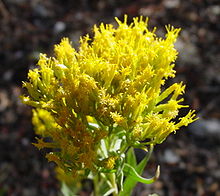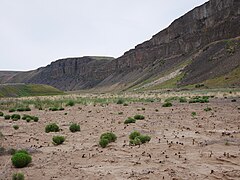| Chrysothamnus viscidiflorus | |
|---|---|

| |
| Conservation status | |
 Secure (NatureServe) | |
| Scientific classification | |
| Kingdom: | Plantae |
| Clade: | Tracheophytes |
| Clade: | Angiosperms |
| Clade: | Eudicots |
| Clade: | Asterids |
| Order: | Asterales |
| Family: | Asteraceae |
| Genus: | Chrysothamnus |
| Species: | C. viscidiflorus |
| Binomial name | |
| Chrysothamnus viscidiflorus (Hook.) Nutt. | |
| Synonyms | |
Synonymy
| |
Chrysothamnus viscidiflorus is an American species of shrub in the family Asteraceae known by the common names yellow rabbitbrush and green rabbitbrush.
Description
Chrysothamnus viscidiflorus grows up to about 150 centimeters (5 feet) in height, with spreading, brittle, pale stem branches. The leaves are up to a few centimeters long and may be thin and thread-like or up to 1 cm wide and oblong. They are glandular, resinous, and sticky.
The inflorescence is a bushy cluster of flower heads, each head 0.5–1 cm long. The flower head is lined with sticky yellow-green phyllaries and contains several yellowish protruding flowers.
The fruit is a hairy achene a few millimeters long with a wispy pappus at the tip.
Subspecies and varieties
Subspecies and varieties include:
- Chrysothamnus viscidiflorus subsp. axillaris (D.D.Keck) L.C.Anderson — desert slopes in Arizona, California, Colorado, Nevada, Utah
- Chrysothamnus viscidiflorus subsp. lanceolatus (Nutt.) H.M.Hall & Clem. — Pennington County in South Dakota
- Chrysothamnus viscidiflorus subsp. planifolius L.C.Anderson — Arizona
- Chrysothamnus viscidiflorus subsp. puberulus (D.C.Eaton) H.M.Hall & Clem. — alpine zones in Arizona, California, Idaho, Nevada, Oregon, Utah
- Chrysothamnus viscidiflorus subsp. viscidiflorus — alpine talus in most of the species range
- Chrysothamnus viscidiflorus var. latifolius
- Chrysothamnus viscidiflorus var. serrulatus (Torr.) Greene — Utah, Nevada
- Chrysothamnus viscidiflorus var. stenophyllus
- Chrysothamnus viscidiflorus var. viscidiflorus
Chemistry
Chrysothamnus viscidiflorus contains an unusual m-hydroxyacetophenone derivative, named viscidone, and chromanone derivatives.
Distribution and habitat
The plant is widespread in North America across much of the western United States and western Canada, from British Columbia and Montana south to California and New Mexico, with a few populations in the Black Hills of South Dakota and in western Nebraska, as well as in South America in the Andean valleys of Chile and Argentina.
The species grows in sagebrush and woodland habitat. It grows easily in alkaline and saline soils, and thrives on soils that are rich in calcium. It rapidly establishes in disturbed habitat, including burns, flooded washes, and rockslides, so it is a valuable shrub for revegetating damaged land such as overgrazed rangeland and abandoned mining areas.
Ecology

It is a larval host to the sagebrush checkerspot and it is an important nectar source in the fall. Range animals such as deer and antelope browse the foliage. It often occurs with Ericameria nauseosa.
Chrysothamnus viscidiflorus plants are typically killed by fire, but can resprout with sufficient energy reserves, and their windborne seeds can blow into a burned area and sprout vigorously. The numbers of plants often increase shortly after a fire and can dominate the landscape, but decreases as Artemisia tridentata (big sagebrush) recolonizes an area.
References
- Greene Erythea 3(6): 94–95 1895
- "Chrysothamnus viscidiflorus". Germplasm Resources Information Network. Agricultural Research Service, United States Department of Agriculture. Retrieved 24 December 2017.
- ^ Flora of North America, Yellow or sticky-leaf rabbitbrush, Chrysothamnus viscidiflorus (Hooker) Nuttall
- ^ Subspecies and varieties recognized by USDA — Chrysothamnus viscidiflorus Subordinate Taxa . accessed 5 September 2015
- ^ Subspecies recognized by Calflora Database for Chrysothamnus viscidiflorus . accessed 5 September 2015
- Subspecies recognized by The Plant List, Chrysothamnus viscidiflorus, Kew Gardens, London.
- Subspecies distributions from Flora of North America.
- Jepson Flora Project (ed.). "C. viscidiflorus subsp. axillaris". Jepson eFlora. The Jepson Herbarium, University of California, Berkeley.
- Jepson Flora Project (ed.). "C. viscidiflorus subsp. lanceolatus". Jepson eFlora. The Jepson Herbarium, University of California, Berkeley.
- Jepson Flora Project (ed.). "C. viscidiflorus subsp. puberulus". Jepson eFlora. The Jepson Herbarium, University of California, Berkeley.
- Jepson Flora Project (ed.). "C. viscidiflorus subsp. viscidiflorus". Jepson eFlora. The Jepson Herbarium, University of California, Berkeley.
- Greene, Edward Lee 1895. Erythea 3(6): 96
- Ngo, le-van; Thi, Van Cuong Pham (1981). "An unusual m-hydroxyacetophenone and three new chromanone derivatives from Chrysothamnus viscidiflorus". Phytochemistry. 20 (3): 485. Bibcode:1981PChem..20..485N. doi:10.1016/S0031-9422(00)84171-0.
- Biota of North America Program 2014 county distribution map
- ^ "SPECIES: Chrysothamnus viscidiflorus". Fire Effects Information System (FEIS). USDA Forest Service.
- The Xerces Society (2016), Gardening for Butterflies: How You Can Attract and Protect Beautiful, Beneficial Insects, Timber Press.
- ^ Taylor, Ronald J. (1994) . Sagebrush Country: A Wildflower Sanctuary (rev. ed.). Missoula, MT: Mountain Press Pub. Co. p. 144. ISBN 0-87842-280-3. OCLC 25708726.
External links
- USDA Plants profile for Chrysothamnus viscidiflorus (yellow rabbitbrush)
- CalFlora database: Chrysothamnus viscidiflorus (green rabbitbrush, stickyleaf rabbitbrush, yellow rabbitbrush) — with subspecies links
- Jepson eFlora, The Jepson Herbarium, University of California, Berkeley
- NPIN−Lady Bird Johnson Wildflower Center: Chrysothamnus viscidiflorus
- Flora of Eastern Washington and Adjacent Idaho: Chrysothamnus viscidiflorus
- Southwest Colorado Wildflowers
- Goldenweeds and Rabbitbrush Found East of the Cascade Mountains of Oregon and Washington: Chrysothamnus viscidiflorus ssp. lanceolatus — (green rabbitbrush, lanceleaf rabbitbrush, yellow rabbitbrush)
- University of California, Calphotos photo gallery — Chrysothamnus viscidiflorus
- [REDACTED] Media related to Chrysothamnus viscidiflorus at Wikimedia Commons
| Taxon identifiers | |
|---|---|
| Chrysothamnus viscidiflorus |
|
| Crinitaria viscidiflora | |
- NatureServe secure species
- Astereae
- Flora of the Northwestern United States
- Flora of the North-Central United States
- Flora of the Southwestern United States
- Flora of Western Canada
- Flora of the California desert regions
- Flora of the Great Basin
- Flora of the Sierra Nevada (United States)
- Natural history of the Mojave Desert
- Plants described in 1840
- Taxa named by Thomas Nuttall